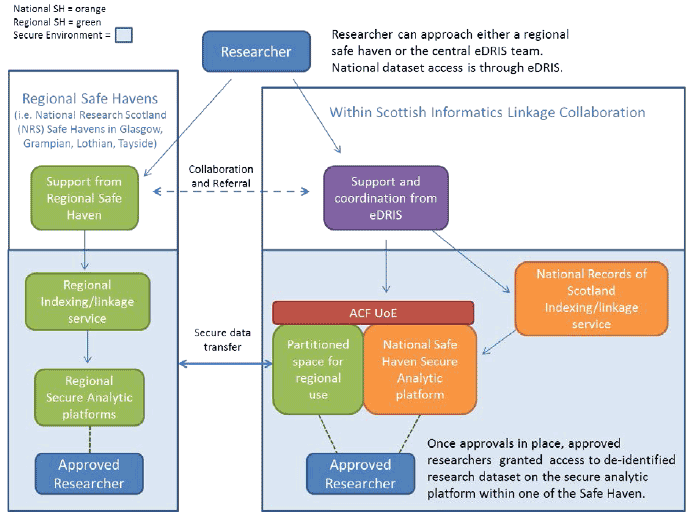Charter for Safe Havens in Scotland: Handling Unconsented Data from National Health Service Patient Records to Support Research and Statistics.
The Charter for Safe Havens sets out the agreed principles and standards for the routine operation of Safe Havens in Scotland where data from electronic records can be used to support research when it is not practicable to obtain individual patient consent while protecting patient identity and privacy.
A Federated Network of Safe Havens
Creation of Safe Havens is expensive, technically challenging and highly specialised in terms of the technological and governance requirements that need to be in place. Hence NHS Boards have created Safe Havens in conjunction with Universities with specialised units or with accredited commercial organisations who employ core support staff who provide a managed technical Safe Haven service as data processors. These services can be offered to other NHS Boards under robust governance arrangements agreed with the Data Controllers of the contracting Boards. Some units also offer other informatics services in addition to the Safe Haven service.
Currently, there are five Safe Haven services in Scotland that have been commissioned by NHS Scotland Boards: one in each of the four lead regional NHS Research Scotland (NRS) nodes (in Aberdeen, Dundee, Edinburgh and Glasgow), and a National Safe Haven within Information Services Division (ISD), an expert unit within the Common Services Agency (known as NHS National Services Scotland). . The National Safe Haven is part of the Scottish Informatics Linkage Collaboration (SILC) that also includes the electronic Data Research and Innovation Service (eDRIS)[10] and the National Records of Scotland indexing service. SILC facilitates linkage for research and statistical activities across many sectors including the NHS. The initial technical infrastructure that supports SILC has been funded by the MRC, Scottish Government and NSS through the Farr Institute Scotland[11], a collaboration between six Scottish Universities and NHS National Services Scotland. The NRS nodes received funding, through NRS infrastructure allocations from the Chief Scientist Office, to help establish Safe Havens.
Figure 1: The federated network of Safe Havens created by NHS Scotland Boards. eDRIS=electronic Data and Research Innovation Service, ACF UoE=Advanced Computing Facility University of Edinburgh.

Together, the National Safe Haven within SILC and the four NRS Safe Havens have formed a federated network of Safe Havens in order to work collaboratively to support health informatics research across Scotland (see Figure 1). All the Safe Havens have individual responsibility to operate at all times in full compliance with all relevant codes of practice, legislation, statutory orders and in accordance with current good professional practice. Each Safe Haven may also work independently to provide advice and assistance to researchers as well as secure environments to enable health informatics research on the pseudonomyised research datasets they create. Co-ordination and close collaboration across Scotland is key for international competitiveness; the establishment of this charter and the network will facilitate collaboration between the Safe Havens by ensuring that they all work to the same principles and standards. The governance of SILC involves representatives of the Safe Havens. The technical operation of the federated network and the integration of the Safe Havens with SILC is set out elsewhere[12].
eDRIS was established as a specific ISD function within NSS and provides a single point of contact for advice on research project design and development as well as access via the national Safe Haven to a wide range of national datasets. Given the well-established close working relationship with ISD (the Data Controller of national NHS Scotland datasets), the National Safe Haven may be best placed to take the lead when research requires the processing and linkage of national datasets. Similarly, it is anticipated that data controllers in NHS Boards will select the regional Safe Havens in the NRS nodes to support research that involves the processing and linkage of data using local/regional NHS datasets[6]. However, the federated network allows Safe Havens to work in collaboration, for example, when research studies may require datasets from more than one NHS region to be combined and/or where the specialist skills of a number of Safe Havens can be applied to facilitate a study that requires a range of expertise[6].
eDRIS can act as a first port of call for researchers on behalf of the federated network to coordinate research and advise researchers about what the Safe Havens in the federated network can provide, although each Safe Haven can also be approached by, and work with, researchers directly on regional Health Board data.
All the Safe Havens are committed to the principles and standards set out in this charter and to undergo formal accreditation once an independent accreditation process has been established. The compliance of the Safe Havens to the principles and standards set out in the charter will be assessed regularly by the independent accrediting body and accreditation will be a requirement to operate, once the accreditation system has been established.
Should new Safe Havens be commissioned by NHS Scotland Boards, they will need to agree to operate under this charter, undergo accreditation, and comply with the technical specifications required to link securely to the Safe Havens within the federated network to be a part of the network.
Contact
Email: Pamela Linksted
There is a problem
Thanks for your feedback